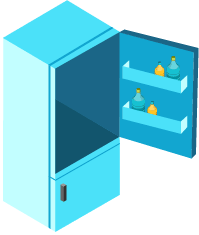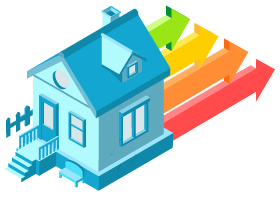Top Tips on How to Lower Electricity Bills in France in january of 2026

Electricity bills are a concern for many households, as these can take up a significant place in a budget, especially during the winter. But there are thankfully many ways to optimise a house or an apartment’s electric consumptions, that are easier to implement than one may think. Below is a list of tips to save money on energy bills, which although they may sound like minor adjustments, if all put together can help save hundreds of euros in bills every year.
Setting the right temperature at home
Accounting for 54% of the average energy consumption for French households (source: ADEME), heating is naturally the first thing to consider altering in order to reduce energy bills.
How to reduce heating bills in winter

It is always best to use heating to best suit your real needs. For instance, it may not be necessary to heat areas where not much time is spent, such as the toilets or the corridor.
In addition, it is recommended to adjust the temperature itself to each room of a house or an apartment, depending on the time of day, as follows:
- 19ºC (66ºF) in the living room during the day, and 16ºC (61ºF) at night;
- 21ºC (70ºF) in the bathroom during the day, and 19ºC (66ºF) at night;
- 16ºC (61ºF) in bedrooms during day and night.
Lowering a room’s temperature by just 1ºC can decrease electricity bills by an average of 7%! Moreover, in France, just 1 kWh produces the equivalent of 0.09g of CO2! Facts that make it worth wearing a jumper instead of turning up the heat.
Optimising the use of radiators
The next thing to consider are radiators, which can be optimised to consume less.
Optimising radiator heat diffusion

It is important to make sure radiators have enough space around them to function properly and diffuse heat efficiently. Thus, make sure not to obstruct radiators with objects or pieces of furniture, as these will absorb the thermal heat and prevent the hot air from circulating properly.
Radiator maintenance before the winter
It is also important to service radiators regularly: remember to dust them twice a year and purge them at the beginning of the cold season, in order to remove any air bubbles that can prevent air from circulating properly.
Optimising the use of electrical appliances
Electrical devices account for 26% of a household’s consumption (15% from big home appliances and 11% from smaller electronic devices), but their use is easy to tweak to consume less and pay less for electricity.
Saving electricity when cooking
Here are a few easy ways to save on energy bills in the kitchen:

- If you need to heat water on the hob, heat it up in a kettle beforehand before adding it to a saucepan.
- Stick the lid on a pan during cooking, as this will reduce heating time fourfold, as well as saving up to 20% energy.
- Turn the hob off a few minutes before the end of cooking time.
- Beware of microwaving: it uses 5 times more energy than a traditional oven! So if you are trying to reduce bills, only use it occasionally and for short cooking times.
- In most cases, it really isn’t necessary to preheat an oven - only do this for cakes and other bakes. Likewise, opening an oven door while it’s functioning will make the oven lose 20% of its warmth and will extend the cooking time. The best bet is to use the oven internal light to check for cooking status.
- Also, make sure to clean your oven regularly.
- Induction plates need 50% less electricity than classic plates to function, as they heat food through significantly quicker.
Taking good care of refrigeration devices

Fridges and freezers are the two most energy-consuming home appliances, and even more so when they aren’t used properly. A fridge temperature should be set to between 2.7ºC (35.6ºF) and 4ºC (39.6ºF), and a freezer at -18ºC (-0.4ºF). Anything below that will use up significantly more electricity, so check their temperatures now and then and adjust it if needed.
Also, be careful where you place your fridge and freezer: make sure they aren’t next to heating appliances, radiators or in contact with direct sunlight (or even better, have it installed in a cold area, such as in a cellar or a garage).
Remember to regularly defrost your appliances (ideally, before a 3 mm layer of frost appears), otherwise, they will use up to 30% more energy to function. Doing this alone can save you up to 30€ in bills per year.
Last but not least, it is important to note that fridges and freezers contain circuits that actually produce a lot of heat, which should be evacuated efficiently so as to avoid overconsumption. Just make sure your appliances aren’t in contact with a wall or ceiling- a 10cm gap behind the appliance and above it should do the trick. Also, remember to dust the air vents twice a year.
Buying eco-friendly devices and light bulbs
Buying energy-saving devices and lightbulbs is not only a smart eco-friendly move but also a sure way to reduce your bills, especially if your home is equipped with a lot of electrical devices and lamps.
Check the energy efficiency labelled (named “Étiquette énergie”) on new devices before making a purchase.

Leading up to 2019, A+++ or A++ are the best ratings to go for, as these meant these so-rated devices consumed between 20 and 50% less electricity to function compared to an A-rated item.
Starting in 2019, this “Étiquette énergie” rating is going to be revised and made simpler, with the highest-ranking becoming A and the lowest G. So, look out for the highest-rated devices - this simple switch, especially for very energy-greedy appliances (hairdryers, fridges, lightbulbs…) can add up to a total of 3000€ in savings over the lifespan of the devices (source: ADEME).
Using devices at optimal hours of the day
If you are under a dual-tariff electricity contract known as Heures pleines / Heures creuses (which separates “heures creuses”, i.e off-peak hours from “heures pleines” i.e peak hours), you should make the most of your “heures creuses” (which are typically an 8-hour daily window indicated on your energy bills, during which the cost of electricity will be cheaper - from 10 pm to 6 am for instance). By using appliances during this time as much as possible (putting the dishwasher on right before going to bed if this is when your heures creuses are set, for instance), this will significantly reduce bills overtime. Some appliances are even designed so that you can set them to function during these times.
Limiting the consumption of certain devices
Another tip you can implement is to limit the use of appliances that are very energy-consuming. Typically:
- Filling up a dishwasher to the maximum before running a cycle, instead of doing multiple half-full cycles, and setting them to “eco” mode
- Decreasing the use of tumble dryers (which consume twice as much electricity as washing machines) and letting clothes dry manually when possible
- Setting the washing machine cycle temperature to 30ºC (86ºF) instead of 90ºC (194ºF) - this can result in a 50% saving
- Turning off devices that are in standby mode - you may not realise it but this is a big energy waste culprit, with households in France having between 15 and 50 devices in standby at any given time. A 2013 AFP-Powermetrix went as far as to show all the standby devices in France together consumed the equivalent of 2 nuclear plants! In order to stop this, you can simply unplug all the devices once you stop using them: DVD player, microwave, computers, coffee machine… If this is too complicated, an alternative is to plug all devices placed in the same room to one unique multi-socket extension, which you can simply switch off when you leave that room.
- When buying a new TV, opt for one with a lower screen power (below 800W) and avoid having multiple TVs around the home
- Unplug your phone or computer from its charger once they are fully charged
Look out for the main culprits of energy consumption in your home, and once you have identified these you can take the next steps to reduce their impact. Typically, the majority of a household’s bills will go to heating (accounting for an average 54% of a household’s electric consumption), hot water (15%), home appliances (15%), electronic devices (11%), lighting (3%) or air conditioning (2%). All these costs can seriously add up.
Optimising lighting at home
A French household has an average of 25 lighting sources, which can definitely add up when it comes to your monthly bills. But there are a lot of simple ways to counter this:

- On top of favouring eco-friendly bulbs, buy LED lamps instead of halogen ones for bedrooms - you’ll save an extra 75% electricity by doing so. For rooms such as the kitchen or bathroom, neon lights work best as they consume little energy while still being very powerful.
- Make the most of natural light as much as possible: for instance, place your desk or reading area right by a window to benefit from maximal daylight, and open your stores and curtains as soon as it’s light outside.
- Opt for pale and light colours for your walls and lampshades
- Adapt a light bulb’s power to the use you need it for: a 20W low power bulb will be more than fine for reading, and a 5W bulb is more than enough in a TV room.
- Finally, although it may sound obvious to many, remember to turn a light off once you leave a room
Regularly controlling boiler maintenance
The annual boiler servicing
For gas-fuelled boilers in France, it is mandatory to proceed to a boiler servicing once a year. This legal requirement, which has to be carried out by a professional, can not only extend a boiler’s lifespan by several years but can also save you between 8 and 12% on your electricity bills. This is also a safe way to prevent a gas leak and a potentially life-threatening carbon monoxide intoxication
Setting the right temperature for the water heater
You can also make sure that your water heater is set to between 55 and 60ºC (131 and 140ºF) - a temperature high enough to limit the growth of bacteria while still being very comfortable, and leading to cheaper bills compared to if it were set at a higher temperature.
Subscribing to a cheaper electricity provider
There are many energy providers to choose from in France, some cheaper than others. This is why comparing offers is very important before signing up to a contract if you want to make sure you are getting the best deal.

Already subscribed to an energy contract? That isn’t a problem since the process of changing energy suppliers is free, easy and straightforward - it only takes one phone call, that’s it. No technical operation is needed, as the electricity remains the same and only your bills and the price you pay will change. With this in mind, it may be worth considering changing your energy provider - especially if you a subscribed to a regulated tariff offer.
Here is a selection of some of the cheapest electricity suppliers as of 2019:
Opting for self-consumption and renewable energy to cut down on bills
Another way to lower your energy budget is to consider self-consumption. These come with major benefits and are also eligible for financial help from the French government.
Self-consumption in France
While still a relatively marginal practice, self-consumption is a way of consuming in a more eco-friendly way while significantly decreasing energy bills.

Simply put, self-consumption is the fact of producing your own electricity, to either use in at home or resell to a renewable energy provider. The electricity can come from air, water, or more commonly from the sun. Using the sun as the source of energy is particularly interesting, not only because photovoltaic panels are fairly easy to install, take up a lot of space and blend quite well in the landscape, they also are supported by the French Government through financial aids (see below).
Thanks to solar panels, or devices such as the Smartflower (provided by EDF in France), any household can enjoy a sustainable and autonomous way of heating and lighting their home, which over time can become a decently profitable activity. This said, in times when the panels don’t produce enough energy to fulfil all of a house’s needs (at nighttime or during a storm for instance), the national electricity network takes over automatically and the electric meter will calculate this extra energy consumed.
Some energy providers, such as Ilek, offer complete assistance with the solar panel installation, in order to encourage its customers to transition towards self-consumption. The supplier also provides a free tool on its website to quickly calculate and evaluate the theoretical productivity of a photovoltaic solar panel if you were to install some at home.
Financial help available for self-consumption in France

In order to encourage households to transition towards self-consumption, the French government has put in place several self-consumption financial incentives, namely:
- The resale of electricity to a provider is exonerated from taxes
- A self-consumption investment bonus (“prime investissement autoconsommation”) given to all self-consumption users every 5 years, which depends on the power of the installation (typically between €1,200-€10,000)
Investing in heat pumps
Heat pumps in France are also a promising way of both reducing energy bills and investing in renewable energy. They work by moving heat from one location to another by using only a small amount of energy. It is a reliable, efficient and cheaper way of obtaining heat and hot water.
Depending on the characteristics of your home and your electricity needs, you can opt for either of these three main types of pumps:
- An air-source heat pump (aerothermal), which pump outside air and inject it into the heating system. This type works well in moderate climates and is fairly cheap to install.
- A water source heat pump (hydrothermal), which requires to have a lake or access to a nearby as it uses the mechanical energy from a water source to produce electricity through an electric generator.
- A ground source heat pump (geothermal), which use thermal energy stored underground to transfer heat to the heating system. Since the underground temperature is steady and warm, ground source heat pumps are very efficient heating devices, but this said they are quite pricey and complicated to install as they require to excavate and put in place a system of underground piping.
A heat pump can typically be used for over 20 years, as long as they are kept well maintained. Similarly to solar panels, heat pumps can come with interesting financial benefits, such as a reduced VAT, a 30% tax credit, a 0% interest loan from certain banks, and help via the Energy Saving Certificate (an operation through which, under specific conditions, you prove you have created energy savings thanks to an investment in renewable energy).
Proceeding to an energy renovation for a home in France
What is energy renovation
The construction sector is the most energy-consuming sector in France, representing nearly half of the total energy consumed in the and responsible for 27% of greenhouse gas emissions in the country. On top of this, 7 million buildings in France are poorly insulated, leaving nearly millions of households cold and struggling to pay their energy bills (source: The French Ministry for the Ecological and Inclusive Transition, 2018).
Rethinking the environmental impact of this sector is thus vital, and this has lead to the French Government to implement a programme known as the Plan de Rénovation Énergétique des Bâtiments (Energy Renovation Plan for Buildings).
This plan aims at not only renovating public buildings but also helping all households, rich and poor, to make their homes better insulated and less expensive to live in.
Financial help available for energy renovation in France
Proceeding to an energy renovation can be rewarded with a big range of financial aids.
- A tax credit specific to Energy Transition (or CITE, Crédit d’Impôt pour la Transition Énergétique): through which you can deduct the cost of the works from your income tax, so long as these works improve your energy performance and that the house or apartment is over 2 years old.
- A 0% interest “ecology” loan (“eco-prêt à taux zéro”), which is accessible to all regardless of income and enables households to finance the renovation of their primary home, interest-free.
- Financial aid from certain certified energy providers (EDF, Total, Engie…) to carry out energy-saving works, so long as these are done by a certified professional...
- A waiver from the French property tax, in some French departments and cities
- VAT reduced to 5.5%: for works done to improve energy quality (investing in items such as a condensing boiler, thermal insulating materials, insulating shutters...) in houses or apartments over 2 years old, whether used as a primary or secondary residence
- Aid from the ANAH, the French National Housing Agency, for underprivileged households with only modest incomes, living in homes that are over 15 years old
- The “Chèque Énergie”, which is an aid between €48 and €227 (depending on the size and characteristics of the household), accessible to disadvantaged households to help them pay their bills.
 alt="energy in france" />
alt="energy in france" />



